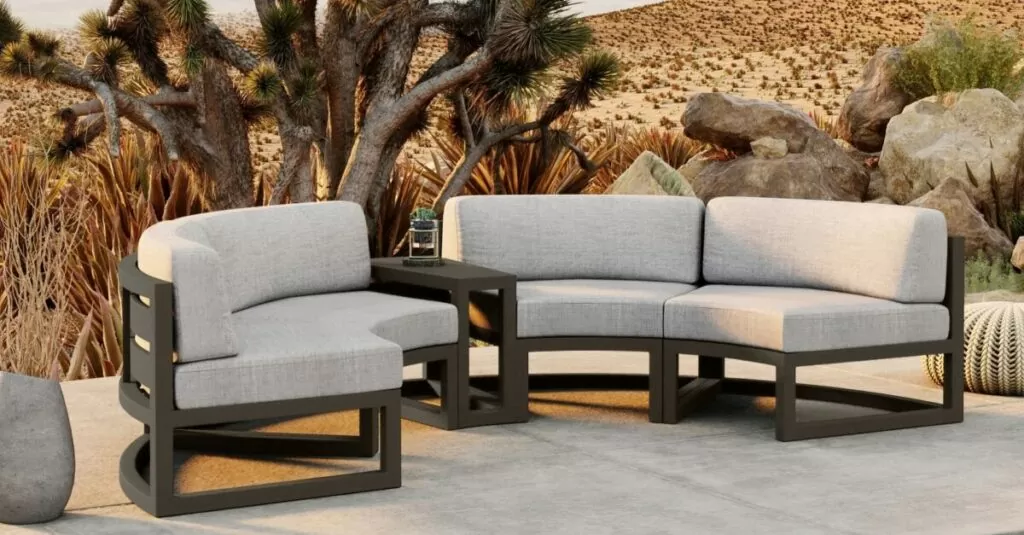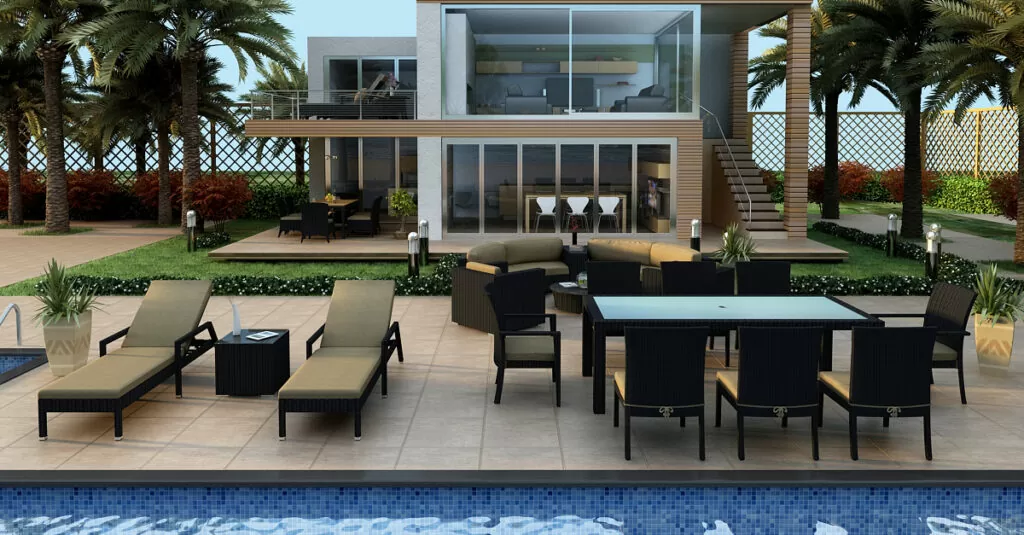Adirondack chairs are an iconic symbol of relaxation and the great outdoors. With their sloped seats, tall fan-shaped backs, and wide armrests, these chairs seem specially designed for lounging lakeside or on a patio. But where did these chairs come from, and how did they get their name? This definitive guide will explore the fascinating history and timeless design of the classic Adirondack chair.
The Origins of Adirondack Chairs
While today the name “Adirondack chair” is instantly recognizable, these outdoor chairs actually originated under a different name. The first chairs of this style were created around 1900 in the Adirondack Mountains region of upstate New York.
Thomas Lee, a summer vacationer, was staying in Westport, New York when he decided to solve a frequent lakeside annoyance – chairs tipping over on the steeply sloped shores. Lee designed a chair with slanted seat and a tall, tilted back to sit level on uneven ground. The chairs were originally made of knot-free Eastern white pine or Eastern hemlock in a single piece.
Lee called his chairs “Westport plank chairs” and locals soon embraced them for relaxing in the great outdoors. Around 1903, Lee got his friend Harry Bunnell, a Westport boat builder and carpenter, to help manufacture the chairs for sale.
By 1905, Bunnell began advertising his own version of the “Westport Chair”, although Lee’svelt the design was largely his own. Some key modifications Bunnell made were adding a tufted seat cushion, creating designs for footrests, and a removable tray across the arms to hold food, drinks, or books.

The Name “Adirondack” Takes Hold
How did these “Westport chairs” become known as Adirondack chairs? The change happened slowly as the chair’s design spread from the quiet lakes of Westport to the broader Adirondack region.
As more manufacturers in the Adirondacks began producing similar chairs, they were commonly referred to as “Adirondack chairs.” By the 1920s, the name Adirondack chair became cemented in the vocabulary even though Lee’s originals were called Westport chairs.
The linkage to the Adirondacks makes sense – the chair design echoes the spirit of this rugged natural paradise. The sturdy yet comfortable chairs seem as welcoming as a hidden mountain lake. Given how entwined the chairs are with relaxing in nature, it is no wonder the name Adirondack stuck.
The “Cure Chair” – Adirondacks for Health
At the turn of the century, Adirondack chairs became linked to another aspect of the Adirondacks – fresh mountain air as a “cure” for lung diseases like tuberculosis. The region grew famous as a health retreat, with sanitariums springing up for those seeking the restorative power of the outdoors.
Doctors recommended patients relax outside daily, exposing their weakened lungs to cool, crisp air. Adirondack chairs provided the ideal furniture for sitting outside comfortably. The chairs became known as “cure chairs” and were marketed to not only patients but any city-dwellers seeking health benefits.
By the 1940s and 50s, as new medicines lessened the threat of diseases like tuberculosis, the image of Adirondack chairs shifted to be more broadly associated with leisure and vacationing. However, echoes of their therapy chair roots remain in their laidback, open design.
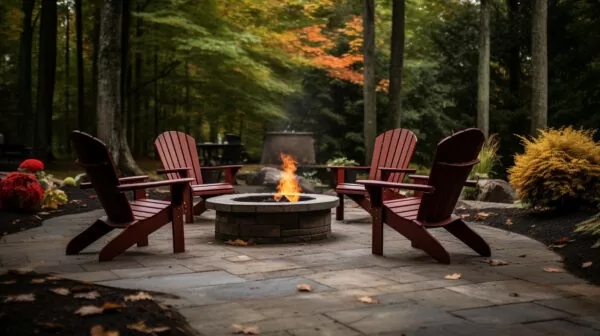
The Evolution of Adirondack Chair Designs
The original Adirondack chairs were simple – just a few planks for seat, back, and arms. But innovations soon emerged to improve comfort, functionality, and style.
Early 1900s: Bunnell’s Improvements
As mentioned earlier, Harry Bunnell made some of the first modifications to Lee’s original plank chair design. He added a comfy tufted seat cushion for extra comfort and created an integrated footrest. For convenience, he added a removable tray that sat across the chair arms to hold food, beverages, and other items. Lastly, he adapted the design to hold a bedpan for bedridden patients, transforming the outdoor chair into a medical tool.
1930s: Irving Wolpin’s Curved Back Design
In the 1930s, furniture designer Irving Wolpin introduced an Adirondack chair with a dramatically arched back comprised of five curved wooden slats. This fanned back offered more comfort and became one of the most popular Adirondack variations. The contoured seat in Wolpin’s design was another update appreciated by sitters.
1940s & 50s: New Materials Emerge
In the postwar period, chair designers began experimenting with new manmade and metal materials. This allowed mass production of Adirondack chairs using less expensive processes. Plastic, steel, and aluminum chairs became available even if they lacked the wood models’ charm.
1980s: Foldable Adirondack Chairs
As outdoor living became more popular in the 1980s, foldable and stackable Adirondack chairs emerged for easy storage and portability. Hinges let the chair back fold flat and legs stack together when not in use. These collapsible versions trade some sturdiness for increased convenience.
1990s: Recycled Plastic Adirondacks
One 1990s innovation combined environmentalism with outdoor chair design. Vermont furniture company POLYWOOD created the first recycled plastic Adirondack chairs, diverting tons of waste from landfills. The original color was a bright green made from recycled milk jugs.
2000s: Customization Rules
Recent years have seen an explosion in customized Adirondack chairs. Thanks to digital fabrication from 3D modeling, existing chair designs can be easily modified and adapted. Contemporary Adirondack chairs may feature integrated ottomans, unique sculptural shapes, or modular seating arrangements. The spirit of innovation begun by chair pioneers like Lee and Bunnell lives on.
How to Choose the Perfect Adirondack Chair
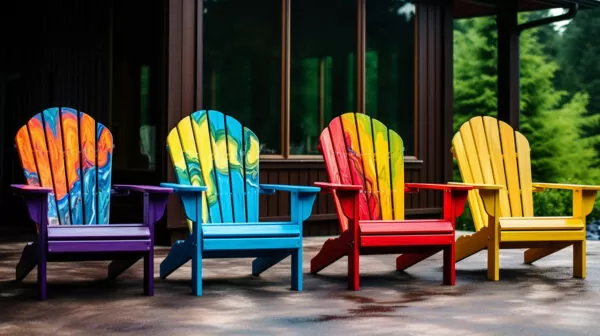
Classic Adirondack Chair Design Features
Over a century of modifications have passed since the original Westport plank chairs. But at their core, certain essential features remain that define the iconic Adirondack chair.
Tall, Slanted Backrest
The most distinctive feature is the tall, slanted back that peaks at around 39-45 inches off the ground. This high fan-shaped back provides neck support and is canted back at about a 35-degree angle. The tilt helps offset the chair’s sloped seat to sit more upright.
Wide Armrests
Adirondack chairs need wide, flat armrests to counterbalance the low seat and high back. The arms should measure at least 24 inches across and be smooth sanded for comfort. They provide a place to rest drinks, books, or just your elbows.
Waterfall Seat
The seat itself extends from a high point at the front to a lower point in back. This cascading “waterfall” seat makes it easy to sit down and get up from the chair. The seat slope is usually around a 5-10 degree incline.
Slatted Back & Seat
Traditional Adirondacks chairs were carved from thick planks of whole wood. Today’s versions use multiple thin slats for the backrest and seat. This makes them lighter and easier to manufacture. The slats are spaced apart for airflow and give the chair its characteristic striped pattern.
Wide Stance
A wide stance – around 24 inches across – provides stability on uneven terrain. Shorter front legs allow feet to rest flat on the sloped seat. The front legs are angled outward for extra capacity.
Low Profile
Even with a tall back, the overall visual profile of an Adirondack chair is low and horizontal. This adds to the laidback, relaxing quality. The downward linesecho the contours of the human body at rest.
By combining all these features in a unified, flowing form, Adirondack chairs have an inherent organic quality, as if shaped by the mountains and forests that inspired them.
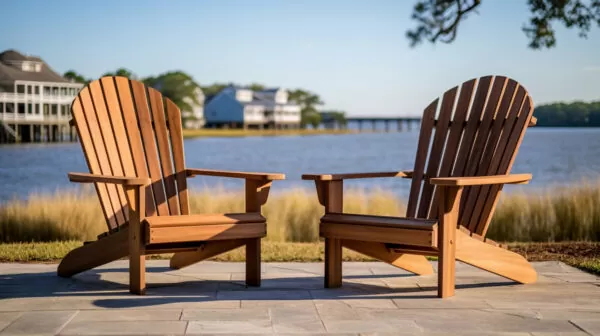
Variations of Adirondack Chair Designs
While the classic form remains popular, Adirondack chairs now come in all shapes and sizes. Here are some of the most common design variations:
Rocking Adirondacks
For ultimate relaxation, a rocking chair base allows gentle motion while sitting in the fresh air. They are great for nursing mothers or anyone who enjoys a soothing rocking sensation.
Folding Adirondacks
Foldable Adirondack chairs offer easy storage and portability. Hinges attach the back to the seat, allowing them to fold vertically when not in use. The legs can also pivot to stack together.
Loveseat Adirondacks
Double wide Adirondack loveseats allow couples or friends to lounge together. They come in side-by-side or face-to-face configurations to enable conversation.
Swivel Adirondacks
Rotating bases let these chairs swivel left or right while seated. This makes it easy to chat with a neighbor or follow the sun’s path without getting up. A 360-degree swivel range is common.
Reclining Adirondacks
For optimal comfort, reclining Adirondacks allow incremental adjustment from upright to a laid-back position. This is great for sunbathing or stargazing on a clear night.
Ottoman Adirondacks
Some Adirondack chairs have matching ottomans that tuck away discreetly beneath the seat. The footstools provide leg support for fully relaxing. Retractable ottomans disappear when not needed.
Curved Back Adirondacks
A curved backrest and contoured seat provide extra comfort and lumbar support. This flowing form often uses a five-slat fanned design.
Suspended Adirondacks
Hanging Adirondack chairs are suspended from chains, ropes, or poles for a floating sensation. These are popular by pools, on porches, or anywhere seeking a swinging chair experience.
The diversity of Adirondack shapes shows these chairs’ versatility. Whether rocking lakeside or reclining fireside, you can find an Adirondack design perfect for watching the world go by.
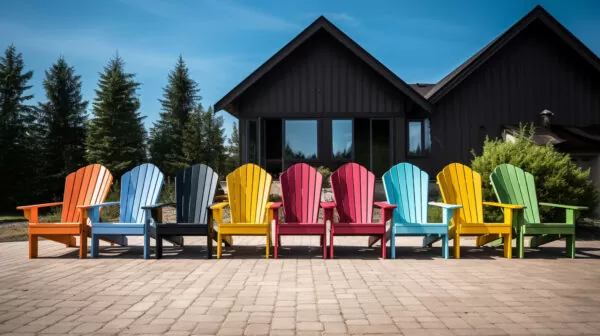
The Takeaway
From their simple origins as “cure chairs”, Adirondack chairs have cemented their status as an iconic piece of outdoor furniture. Hundreds of variations exist while retaining the timeless qualities of comfort, relaxation, and harmony with nature. Materials and technologies have allowed continual adaptation, but the chairs remain entwined with lazy days on the deck and memories made lakeside. So tilt back and relax; you are sitting in over a century of design history. Here’s to the next hundred years of joy found in an Adirondack chair!

Todd is a co-owner of Patio Productions and has worked extensively in the furniture industry since 2002, when he started a company that designed and manufactured bathroom vanities. He now has a hand in all online business operations, including keeping tabs on industry trends and making sure Patio Productions remains an innovative leader in the outdoor furniture space. He lives just outside of Denver, Colorado with his wife, two boys, and two dogs. They live on a lake where they can make the most of the outdoor lifestyle. His favorite patio furniture sets are his Harmonia Living sectionals.



